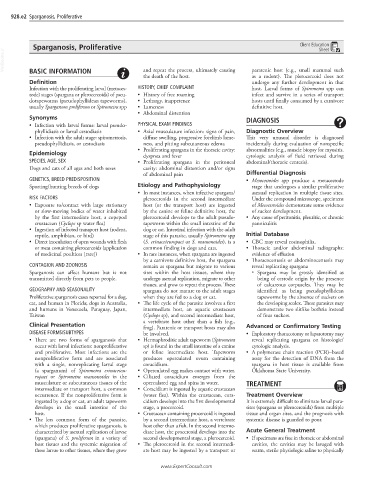Page 1849 - Cote clinical veterinary advisor dogs and cats 4th
P. 1849
928.e2 Sparganosis, Proliferative
Sparganosis, Proliferative Client Education
Sheet
VetBooks.ir
and repeat the process, ultimately causing
BASIC INFORMATION
the death of the host. paratenic host (e.g., small mammal such
as a rodent). The plerocercoid does not
Definition undergo any further development in that
Infection with the proliferating larval (metaces- HISTORY, CHIEF COMPLAINT host. Larval forms of Spirometra spp can
tode) stages (spargana or plerocercoids) of pseu- • History of free roaming infect and survive in a series of transport
dotapeworms (pseudophyllidean tapeworms), • Lethargy, inappetence hosts until finally consumed by a carnivore
usually Sparganum proliferum or Spirometra spp • Lameness definitive host.
• Abdominal distention
Synonyms DIAGNOSIS
• Infection with larval forms: larval pseudo- PHYSICAL EXAM FINDINGS
phyllidiasis or larval cestodiasis • Axial musculature infection: signs of pain, Diagnostic Overview
• Infection with the adult stage: spirometrosis, diffuse swelling, progressive forelimb lame- This very unusual disorder is diagnosed
pseudophyllidiasis, or cestodiasis ness, and pitting subcutaneous edema incidentally during evaluation of nonspecific
• Proliferating spargana in the thoracic cavity: abnormalities (e.g., muscle biopsy for myositis,
Epidemiology dyspnea and fever cytologic analysis of fluid retrieved during
SPECIES, AGE, SEX • Proliferating spargana in the peritoneal abdominal/thoracic centesis).
Dogs and cats of all ages and both sexes cavity: abdominal distention and/or signs
of abdominal pain Differential Diagnosis
GENETICS, BREED PREDISPOSITION • Mesocestoides spp produce a metacestode
Sporting/hunting breeds of dogs Etiology and Pathophysiology stage that undergoes a similar proliferative
• In most instances, when infective spargana/ asexual replication in multiple tissue sites.
RISK FACTORS plerocercoids in the second intermediate Under the compound microscope, specimens
• Exposure to/contact with large stationary host (or the transport host) are ingested of Mesocestoides demonstrate some evidence
or slow-moving bodies of water inhabited by the canine or feline definitive host, the of sucker development.
by the first intermediate host, a copepod plerocercoid develops to the adult pseudo- • Any cause of peritonitis, pleuritic, or chronic
crustacean (Cyclops sp water flea) tapeworm within the small intestine of the panniculitis
• Ingestion of infected transport host (rodent, dog or cat. Intestinal infection with the adult
reptile, amphibian, or bird) stage of this parasite, usually Spirometra spp Initial Database
• Direct inoculation of open wounds with flesh (S. erinaceieuropaei or S. mansonoides), is a • CBC may reveal eosinophilia.
or meat containing plerocercoids (application common finding in dogs and cats. • Thoracic and/or abdominal radiographs:
of medicinal poultices [rare]) • In rare instances, when spargana are ingested evidence of effusion
by a carnivore definitive host, the spargana • Thoracocentesis or abdominocentesis may
CONTAGION AND ZOONOSIS remain as spargana but migrate to various reveal replicating spargana
Sparganosis can affect humans but is not sites within the host tissues, where they ○ Spargana may be grossly identified as
transmitted directly from pets to people. undergo asexual replication, migrate to other being of cestode origin by the presence
tissues, and grow to repeat the process. These of calcareous corpuscles. They may be
GEOGRAPHY AND SEASONALITY spargana do not mature to the adult stages identified as being pseudophyllidean
Proliferative sparganosis cases reported for a dog, when they are fed to a dog or cat. tapeworms by the absence of suckers on
cat, and human in Florida; dogs in Australia, • The life cycle of the parasite involves a first the developing scolex. These parasites may
and humans in Venezuela, Paraguay, Japan, intermediate host, an aquatic crustacean demonstrate two slitlike bothria instead
Taiwan (Cyclops sp), and second intermediate host, of four suckers.
a vertebrate host other than a fish (e.g.,
Clinical Presentation frog). Paratenic or transport hosts may also Advanced or Confirmatory Testing
DISEASE FORMS/SUBTYPES be involved. • Exploratory thoracotomy or laparotomy may
• There are two forms of sparganosis that • Hermaphroditic adult tapeworm (Spirometra reveal replicating spargana on histologic/
occur with larval infections: nonproliferative sp) is found in the small intestine of a canine cytologic analysis.
and proliferative. Most infections are the or feline intermediate host. Tapeworm • A polymerase chain reaction (PCR)–based
nonproliferative form and are associated produces operculated ovum containing assay for the detection of DNA from the
with a single, nonreplicating larval stage coracidium. spargana in host tissue is available from
(a sparganum) of Spirometra erinaceieu- • Operculated egg makes contact with water. Oklahoma State University.
ropaei or Spirometra mansonoides in the • Ciliated coracidium emerges from the
musculature or subcutaneous tissues of the operculated egg and spins in water. TREATMENT
intermediate or transport host, a common • Coracidium is ingested by aquatic crustacean
occurrence. If the nonproliferative form is (water flea). Within the crustacean, cora- Treatment Overview
ingested by a dog or cat, an adult tapeworm cidium develops into the first developmental It is extremely difficult to eliminate larval para-
develops in the small intestine of the stage, a procercoid. sites (spargana or plerocercoids) from multiple
host. • Crustacean containing procercoid is ingested tissue and organ sites, and the prognosis with
• The less common form of the parasite, by a second intermediate host, a vertebrate systemic disease is guarded to poor.
which produces proliferative sparganosis, is host other than a fish. In the second interme-
characterized by asexual replication of larvae diate host, the procercoid develops into the Acute General Treatment
(spargana) of S. proliferum in a variety of second developmental stage, a plerocercoid. • If specimens are free in thoracic or abdominal
host tissues and the systemic migration of • The plerocercoid in the second intermedi- cavities, the cavities may be lavaged with
these larvae to other tissues, where they grow ate host may be ingested by a transport or warm, sterile physiologic saline to physically
www.ExpertConsult.com

